The ability to effectively research is a skill that every student needs to succeed in their educational career. However, most people don’t really understand what research entails. Does it mean spending hours at your university library exploring archives? Or is searching for information online from the comfort of your home enough? And why can’t you just rely on Wikipedia, after all?
Our specialists have created this guide for students who feel lost when putting together an essay, paper, or presentation. Here, we will describe how to research in a detailed, step-by-step manner. We have also provided links to useful tools and resources that will help you along the way. First of all, let’s cover the definitions.
❓ What Is Research?
Research refers to the systematic process of discovering information and developing knowledge. We use it to understand new topics and to gain more insight into known issues. This happens through the collection and analysis of relevant data. The ability to research efficiently is one of the most fundamental skills in academia.
Any type of research will include the following features:
- A sound hypothesis on which the rest of the study is based. It will be either proven or disproven by the evidence gathered.
- Systematic investigative methods. These are controlled and follow a pre-established set of rules.
- Logical analysis. It follows a set procedure that involves deductive and inductive reasoning.
- Empirical data based on actual observation and evidence.
- Analytical study of the findings. This ensures in-depth exploration and minimizes mistakes.
- Creation of new questions and new lines of inquiry about the subject via the research.
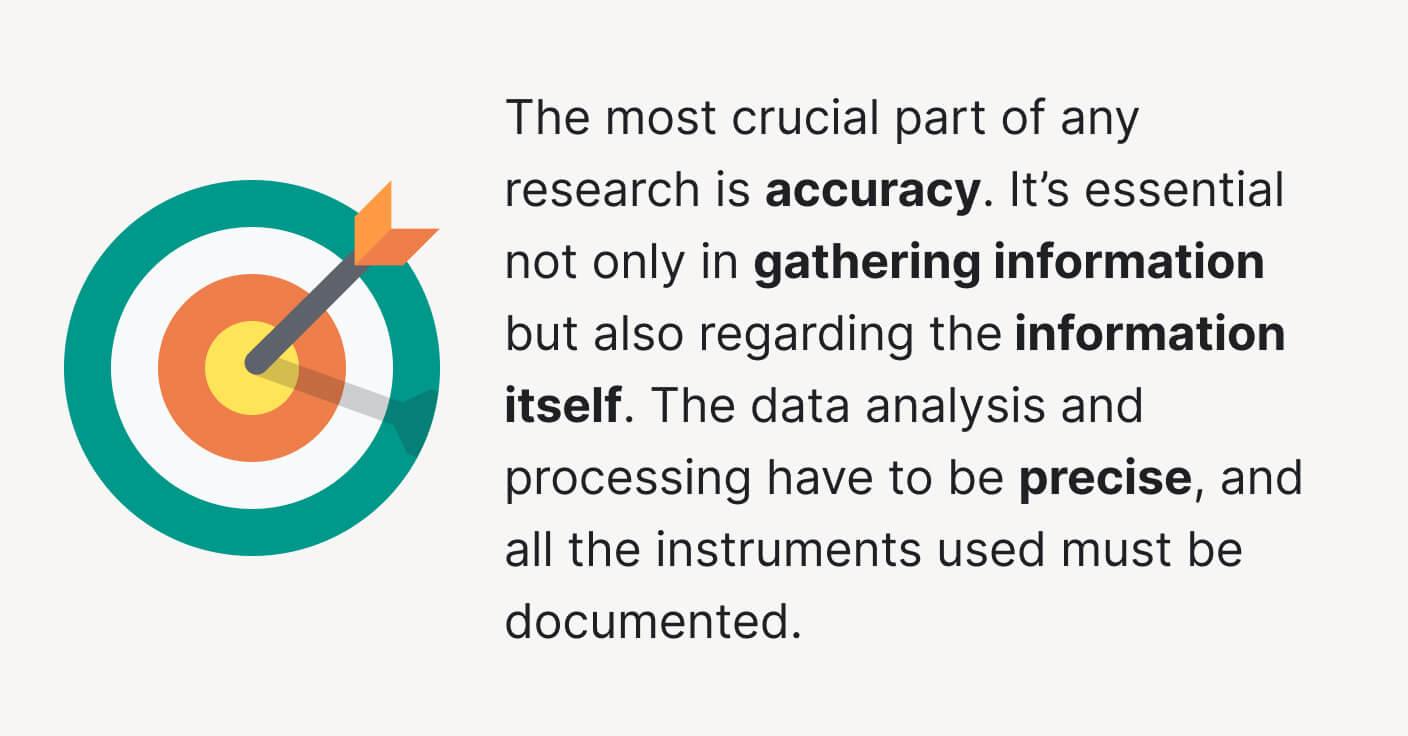
With that being said, a research paper is more than just the sum of its sources. Its primary purpose is to analyze or argue a particular perspective. In the end, your thoughts and ideas should be the ones you investigate. The evidence you discover during the research process will be the basis for your hypothesis.
There are three universal purposes of research that you should know about:
- Exploratory. A problem that hasn’t been investigated before and isn’t clearly defined requires exploratory research. This is the first step in laying the foundation for future, in-depth study. It requires an unstructured approach and posits several questions for the researchers to answer.
- Descriptive. With a focus on an existing problem, descriptive research tries to expand our knowledge of the subject matter. It aims to define, explain, and confirm results. This type of research asks the questions ‘what’ and ‘how.’
- Explanatory. Also known as casual research, the goal here is to look at the cause-and-effect relationship between variables. The main question in this type of research is ‘why.’ That is why it is usually approached with experiments.
📚 How to Research: Step-by-Step Guide
As all the definitions you need are covered, we can proceed to learn about the process itself. We have developed this guide so that you won’t have any trouble conducting your research. In the image below, you can see all the required steps.
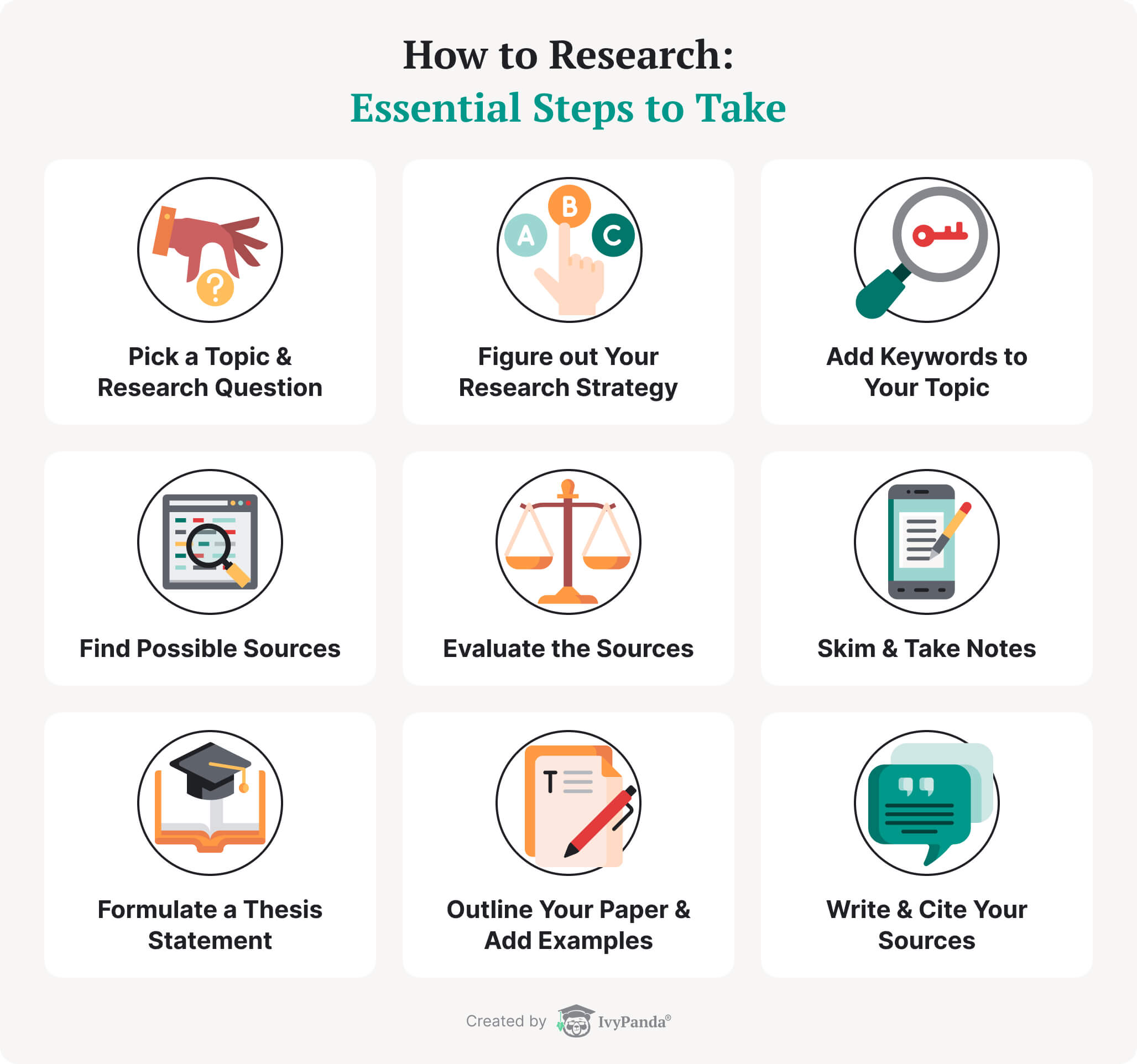
In the following sections, you will examine each step in detail. Also, you’ll see the reasons why our tips are practical and how to find sources for your research. Good luck!
1. Develop a Topic
1.1. Pick or Create a Topic
Start your research by landing on the perfect idea. This process isn’t always effortless, particularly when you aren’t too close with the chosen area. However, don’t panic. You can always change your topic later.
Let’s explore how to select your first research idea.
Research is always conducted for a distinct reason. It will always relate to writing a paper, creating a project, validating existing results, etc. Your analysis depends on the objective of your assignment.
The answers will help you define the direction of your work:
- Do you have a list of pre-assigned titles? Can you come up with one yourself?
- What is the due date for your task? How much time does that leave for research?
- What is the size of your assignment? (Presentation length, number of words/pages, etc.)
- Are there any particular conditions regarding the sources that you can use?
- Is it essential to use recent information and current sources?
When you have answered all the key questions, you can think of your title. These tips will help you:
- Settle on an idea that is applicable to your task. Usually, your instructor will give you detailed instructions before you start working. If you are unsure about your guidelines, don’t be afraid to ask for clarification.
- Ensure that there are enough resources for you to use. When you think of an idea, do a quick preliminary search. It will allow you to determine whether there is enough available information on your topic. Take time to validate those resources and make sure they’re reliable.
- Search for a topic that is not too broad or too narrow. This step directly correlates with the one above. If you are finding too much general information, narrowing down your search might be a good idea. However, if you struggle to find credible sources, it could be a sign to broaden your topic.
- Try to be original. Restating the same ideas that have been explored thousands of times could damage your grade. Chances are, your instructor has heard it all before and isn’t all that interested in hearing it again. Yet, choosing an unconventional approach with a fresh perspective might earn you extra credit for creativity.
- Aim to find an area that will be interesting to explore. If you find a topic that you, personally, are curious about, researching it will be much more pleasant. This way, when you start writing or searching for information, you might actually enjoy the process.
1.2. Formulate Research Questions
As soon as you have chosen a topic, take the time to format it correctly. Wording it as a question will ensure that your focus is precise and nuanced.

And here is how you create research questions:
Step 1: Do some research.
Take a look at the most recent discussions and debates on your selected topic. You can check out academic journals and scholarly conferences. Keep your focus on the main arguments to acquaint yourself with the concepts.
Step 2: Try narrowing down your topic.
It is a lot more effective to target a single dimension of a broader topic than to tackle everything. To do this, try focusing on a particular aspect, such as a specific location or time period. You can also aim to discuss certain debates or issues that exist within the topic.
Step 3: Keep your audience in mind.
There is a difference between crafting a presentation for your classmates and writing a research paper. Your audience will determine the level of detail that goes into your question.
Step 4: Ask questions.
Once you have considered the above steps, it is time to begin asking yourself questions. Make sure they’re open-ended and start with ‘why,’ ‘how,’ or ‘what.’
Step 5: Evaluate your questions.
After you come up with a couple of ideas, jot them down on paper. Look back at all the requirements for a successful research question. Which one of them will be the most effective for your assignment?
1.3. Choose a Research Strategy
To develop constructive research questions, you will need to conduct an initial survey of your resources. Take everything you’ve learned so far as your foundation. Now, you will need to create an efficient strategy for your further actions.
Your research strategy will depend on the following:
1.4. Figure out Keywords
With your research questions, strategy, and some background info covered, it will be easier to determine the keywords. They will help you look for resources and locate your work in the future. Over here, see how to work with keywords.
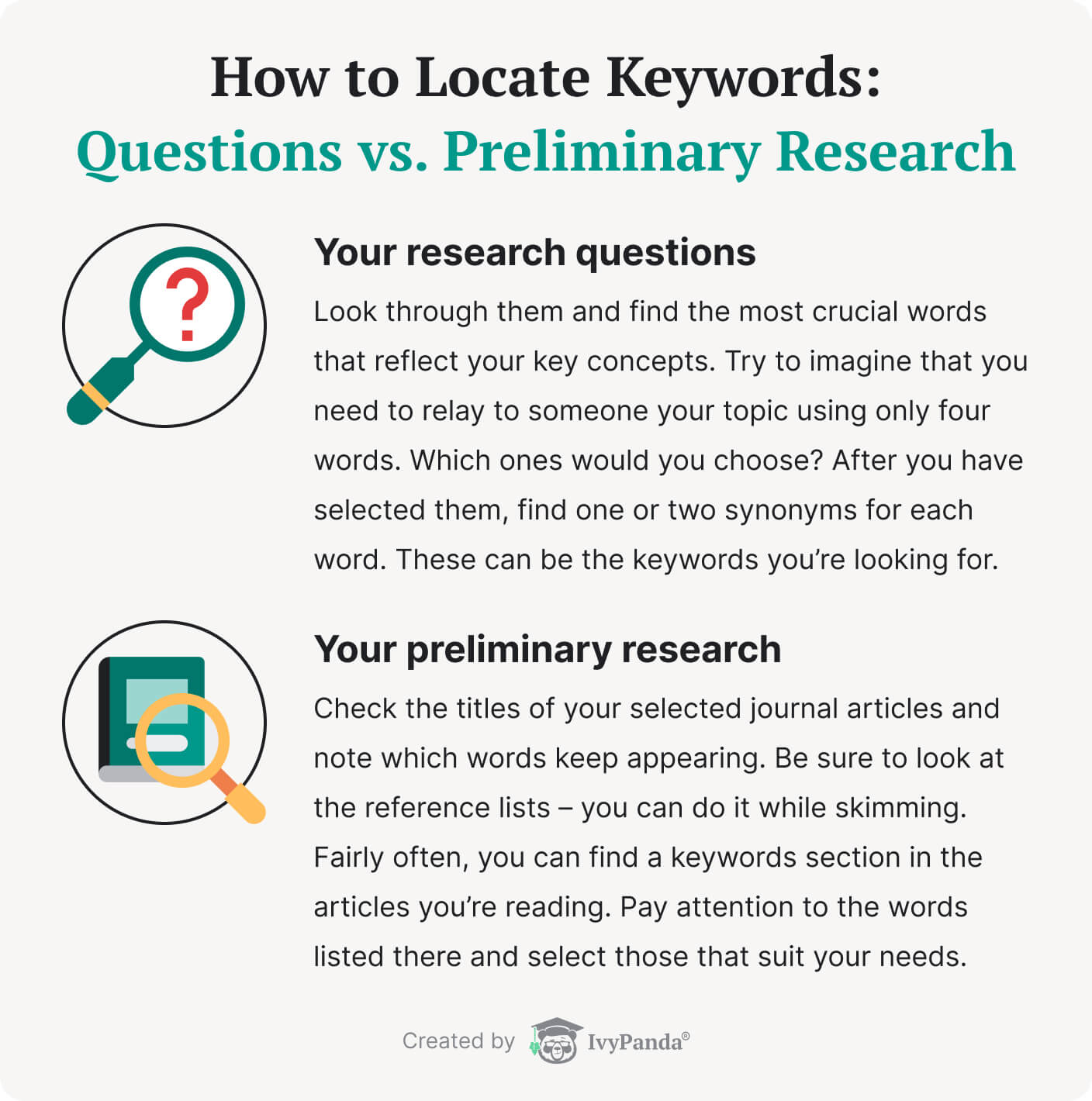
Once you have a selection of keywords, you can improve them by doing the following:
- Break them into related concepts. By the end, you should have four or five columns with associated keywords.
- Choose one keyword from each column. Use your library’s search engine to look them up. Don’t forget to type ‘AND’ in-between the words. It will narrow down the search so that only articles containing all the selected keywords will appear.
- Explore the results! Don’t be afraid to try several different combinations. You should also make sure to list all those keywords that bring you the most valuable results.
- If you don’t have enough results, try using fewer keywords. Alternatively, you can try to make your keywords broader.
- If you have too many results, try using more keywords. Alternatively, you can try to make your keywords narrower.
- Pay attention to which articles are the most relevant to your needs. Make sure to save them and skim them for a list of keywords. Write them down, and create a new list!
- Once you have exhausted your first list, you can create another one. Run another search following these steps. Don’t forget to note down the relevant materials – you’ll need them for your citations!
1.5. Improve Your Topic
As we mentioned above, you can change and refine your topic as many times as you need before you begin writing. That is why in this section, we will talk about how to polish and improve your idea. At the very least, we’ll give you tips on how to format it correctly.
First of all, we need to make sure that your topic is researchable. To accomplish this, answer the 5 ‘w’ questions:
- Why are you choosing this particular topic? How is it interesting or different from the rest? What is your stance on the matter?
- What are the main issues your topic is trying to explore? Is it controversial? What other opinions and questions exist on the subject?
- Who is talking about the topic? What points of view exist, and who is giving them? What is their agenda?
- When was this topic discussed? Is the issue recent or historical? Does the time frame matter?
- Where lays the importance of your topic? Is it debated on an international, national, or local level? Is there a particular place that is more affected than the rest of the world?
After answering these questions, you need to evaluate your idea from these two perspectives:
- Is your topic too broad?
It may happen if you find far too much information on the subject that doesn’t seem relevant. You will want to diminish it and include some specifics, such as:
- Place (country, city, street, part of the world, etc.);
- Time (year, era, century, etc.);
- Populace (ethnicity, gender, age, job, etc.);
- Event or characteristic (historical occurrence, institutional perspective, etc.);
- Individual or group (a particular point of view, specific person or persons, etc.).
- Is your topic too narrow?
If you are retrieving too few materials to build a proper case, your topic is too narrow. Try to broaden it using the following tricks:
- Remove some of the specifics (place, time, populace, etc.).
- Expand some of the specifics (place, time, populace, etc.).
- Use synonyms to reword your topic.
- Look in other databases to broaden your horizons.
- Consider looking into a less current issue (the newer an idea is, the harder it is to find sources).
2. Look Through Sources
2.1. Determine Possible Sources
By this time, you most probably looked for background information on your theme a couple of times. Now look for more accurate info.
For starters, browse the keywords you’ve picked and evaluate if there is enough data available. You can start by checking appropriate titles in the online libraries. Look for sources in encyclopedias and dictionaries to overview what books or articles you can use.
You can use the following websites for this purpose:
- Dictionaries:
- Encyclopedias:
Apart from encyclopedias and dictionaries, there are, of course, other places you can investigate. For instance, you can search for publications in your local or university library. When you look through the text on the shelf, pay attention to the books nearby – they can become useful too in the subject area.
Additionally, you can find data in your textbooks and assigned readings. Use your library’s electronic bases that keep magazines and newspapers on the topic. In case you are unsure how to do that, ask your librarian. Also, use search engines to locate materials on the Internet. These types of sources will be valuable when looking for generic information.
2.2. Skim Some Books
When it comes to using books for your research, both hard and electronic copies work as well. In this section, we will tell you how to use them for your research.
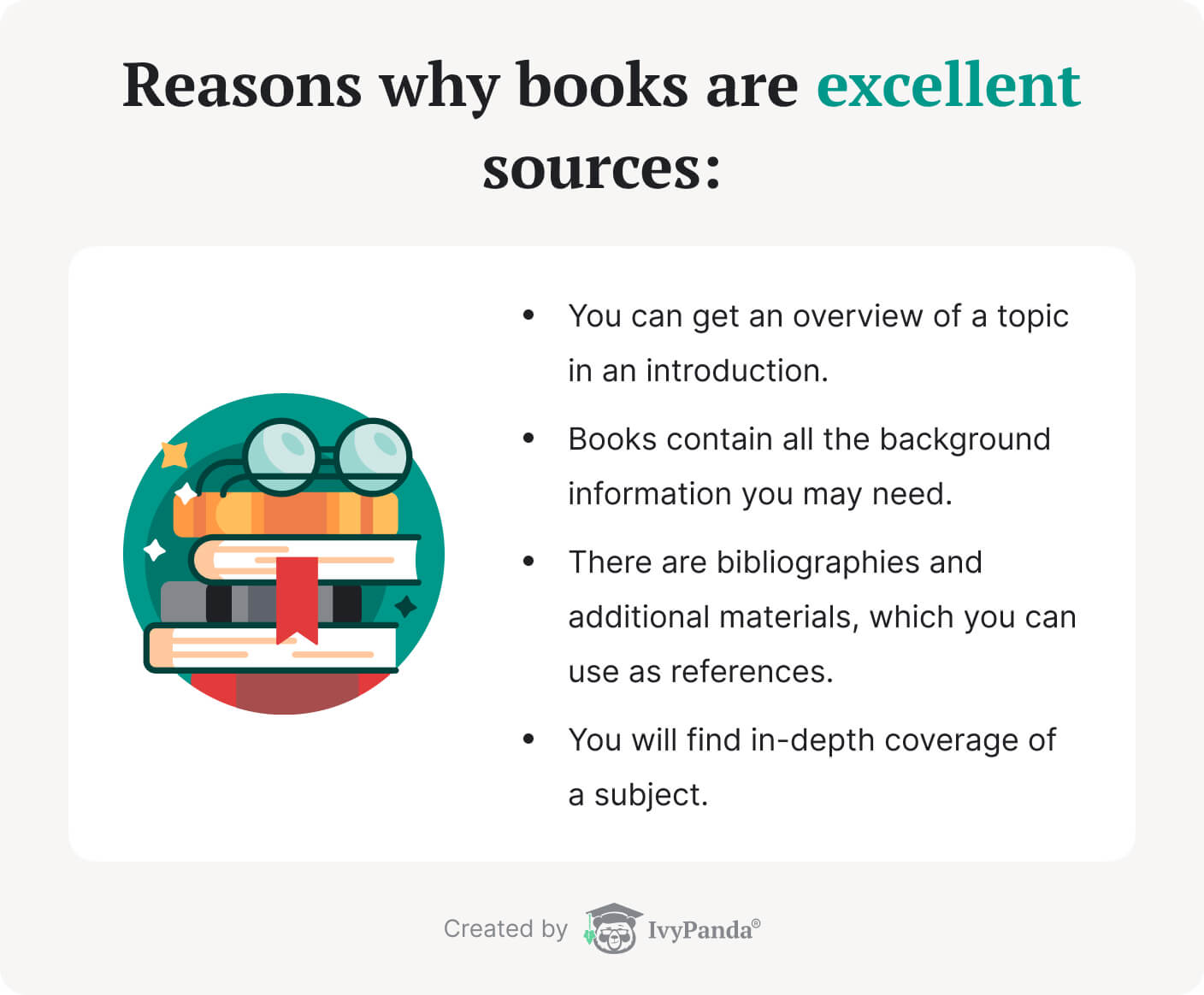
If you are a student, you most likely do not have time to read every single book. When working on a short paper, essay, or presentation with limited time, you are simply looking for citations. Luckily, there is no need to waste your time examining each book thoroughly. Skimming is enough to understand if the source works for you or not.
To locate the needed information in the book, review the following elements:
- Title Page. There, you can find all the crucial details about the book, the author’s name, title, the publisher’s name, the date of publication, etc.
- Table of Contents. This part provides you with a list of all the chapters in the book. You can get a fundamental idea of what topics the author covered.
- List of Illustrations. In some books, authors use pictures, tables, or drawings to support the arguments and the facts. Looking through them can help you see the stats or some other facts quickly.
- Preface or Introduction. Usually, this section of the book provides the author’s intentions and the objective of the book. Read it to see whether the book’s topic is necessary for your research.
- Bibliography. This part of the book offers a list of materials that the author used. You can check the bibliography for additional resources or references.
- Index. Skimming an index is excellent for identifying where the relevant information is located in the book. It can also give you some additional keywords that might be helpful for your research.
How to Find Books: Free Resources
You can find paperback books in your school’s library or ask your professor if he can lend you some helpful resources. To look for ebooks, we recommend using one of the following services:
- Open Library. It is an open library catalog through which you can read and borrow more than 3 million books.
- Google Books. It is a service from Google Inc for full-text books. Google claims that it has over 40 million scanned books.
- Internet Archive. Internet Archive is a free online library of millions of books, movies, software, music, etc.
- Project Gutenberg. It is one of the oldest digital libraries. It stores almost 50,000 ebooks in various formats.
- WorldCat. WorldCat is an online library catalog. It allows you to look up dissertations, books, essays, journals, and multimedia worldwide.
For more free books and textbooks, check out the list of online learning resources for different subjects.
2.3. Find Relevant Articles
Scholarly articles are essential parts of every research. Even small argumentative essays usually contain citations from these resources. Here, we will explain how to work with them.
But first, you have to understand how to differentiate based on where these articles are being published. There are two types:
- Peer-reviewed journals
These journals include articles written by an expert in the field. Another expert (experts) read the article and provided feedback. Thus, the author implemented the needed changes based on the review.
- Scholarly journals
Experts write articles for these journals. They address the papers to other academics in the same field. Usually, scholarly journals are written by professional associations or academic press.
Usually, students can use academic and scholarly journals interchangeably. However, you should ask your instructor to explain if sources called “academic” are acceptable.
To sum up:
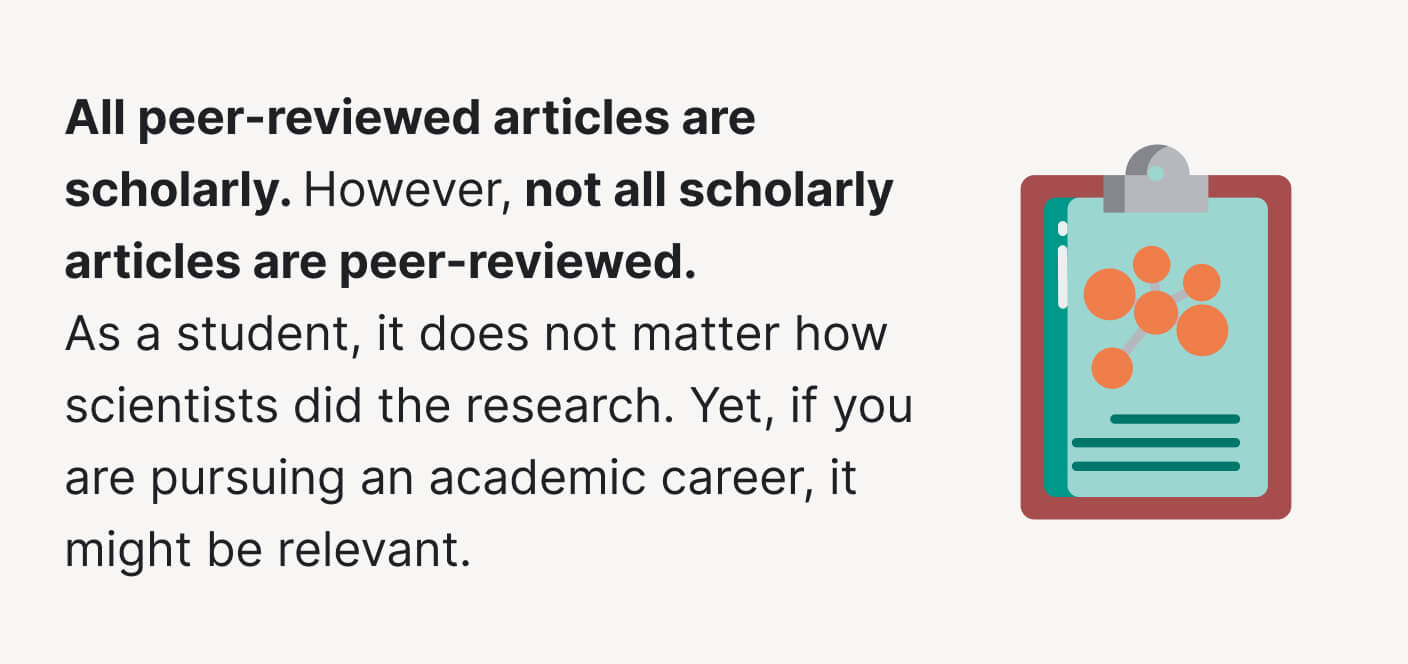
Not to read every single piece of writing, you need to learn how to identify if the article is credible or not. For that, pay attention to the following elements:
- Author. Look out for the author’s degrees and credentials. Additionally, see if they are a member of any association or work at a university or official organization.
- Intended audience. Understanding the article’s aim is essential. If the author intends to entertain and inform the general public, it may not be the best source for a student. You can still read and learn from without citing.
- Publication type. Some of the ways to recognize the type are:
- Go online and read the sections’ “aims and scope.”
- Check the visual appearance. If the article has colorful images and graphics, it is most probably written for the general public.
- Structure. You can also look at the length and formatting of the article. If it has a clear organization with headings, then most probably, the piece is scholarly. Same with the size. Short papers (with less than five pages) in general are likely to be not academic articles.
- Style. Examine the language, the point of view, and the tone of the article. If the document has many technical terms and professional jargon, then it is usually scholarly or peer-reviewed. Ask yourself what level of education one needs to comprehend the text entirely.
If all of the following parameters fit your expectations, you can only start by reading and analyzing the article.
How to Find Articles: Free Resources
Not sure where to look for articles? Check the following resources that our team recommends:
- Google Scholar. Google Scholar is a web search engine that indexes most peer-reviewed journals, books, abstracts, theses, and dissertations. The goal behind this engine is to make access to scientific knowledge more efficient. It also has a citation analysis tool.
- WorldWideScience. WWS is a global science search engine that looks for articles and scientific papers across more than 100 databases. It is partially free and multilingual.
- Microsoft Academic. Microsoft Academic is a web search for scientific knowledge. You look for any topic, author, journal, or combination of the following on the website. Microsoft Academic is entirely free.
- ScienceOpen. ScienceOpen is a complete end-to-end publishing solution that has over 50 million articles and records. It provides a wide range of tools to researchers for free.
- ResearchGate. RG is a European social networking website for scientists and researchers. You don’t have to register to read articles. Yet, you need to have an email affiliated with one of the recognized institutions to become a site member.
- Infotopia. It is a search engine designed for teachers, students, and those doing home school programs. Librarians created it using Google custom search.
- CORE. The CORE is a service provided by the Knowledge Media Institute. The aim is to gain open access to different systems as it works closely with digital libraries. CORE claims that it is the world’s largest aggregator of open access research papers.
- Education Resources Information Center. ERIC is an online library of education research and information. The U.S. Department of Education sponsors it. This library is free of charge and has a lot of filters for the most accurate search results.
2.4. Examine Useful Databases
If you still don’t know what sources to use, you can study databases. These collections contain many high-quality books and articles and conference presentations, video lectures, illustrations, etc. In this section, see how to use them and how to benefit from doing this.
A database is a collection of stored and structured information, usually controlled by a dates management system (DBMS). Information is generally modeled in rows and columns in different tables. Thus, even your university’s online library can be considered a database.

Here are some crucial tips on using databases:
- Use AND, OR, and NOT. When you combine search terms, you need connectors. They will make your search more specific and efficient. For each situation, use a different boolean operator:
- AND ➡️ when you want to use both terms.
- OR ➡️ when you can choose either time.
- NOT ➡️ when you want to exclude words.
- Type asterisks, exclamation points, and questions marks. If you don’t use asterisks and wildcards, some databases will not provide the search you need. They are also beneficial in making your search more specific.
- Look out for the “subject search” option. This way, you will search for information located on the heading field. It is possible due to a system called controlled vocabulary.
- Improve your keywords. Try to be creative with your key phrases and words. Look for all the possible ways to express your topic by using synonyms and associated concepts.
- Try using parentheses. When you look for complex queries, use parentheses. They will allow you to group terms together.
- Search for clues. Carefully look for tips and hints in the results. Analysis of the trends, indications, and numbers can help you understand the information better.
- Check the stacks. Stacks are linear data structures that follow a specific pattern. As collections of elements, they can help you with one particular search.
- Look through different databases. You can look across other databases and combine what you’ve found. The more data you will consider, the more precise your results are.
Free Databases to Use for Research
There are many open-access databases that you can use when conducting your research. Our experts previously mentioned a lot of those in the sections about ebooks and scholarly articles.
Here are some more databases that you can find to be helpful:
- Directory of Open Access Journals (DOAJ). DOAJ is a community-curated online journal. It provides access to high-quality, peer-reviewed journals.
- E-Theses Online Service. EThOS is a bibliographic database provided by the British Library. You can search across 500000+ works for free and access the full text.
- World Bank Open Data. This one is a catalog provided by World Bank. It includes databases, tables, reports, and other resources.
- Science.gov. This database is provided by U.S. Government science agencies. It contains a search engine that will make your search effortless.
- Social Science Research Network. SSRN is worldwide research that contains full-text academic papers. It is an open-access resource for subjects like accounting, economics, finance, law, etc.
We also recommend looking at the available open databases prepared by the University of California at Santa Barbara and Elmira College.
2.5. See Other Websites
Besides search engines and databases, there are other online resources that you can use as a starting point for your research. The only issue is that you might not know if the information is legit.
These websites are suitable for academic research:
- Educational sites (*.edu)
- Government sites (*.gov)
- News sites (CNN, NBC News, FOX News, etc.)
- Professional, nonprofit organizations (Unicef, WWF, etc.)
- General informative websites (Wikipedia)
Of course, you can use online resources for research. They are especially great when you’re looking for background information or defining the topic. Yet, one thing to keep in mind is to choose the websites and data from them carefully.
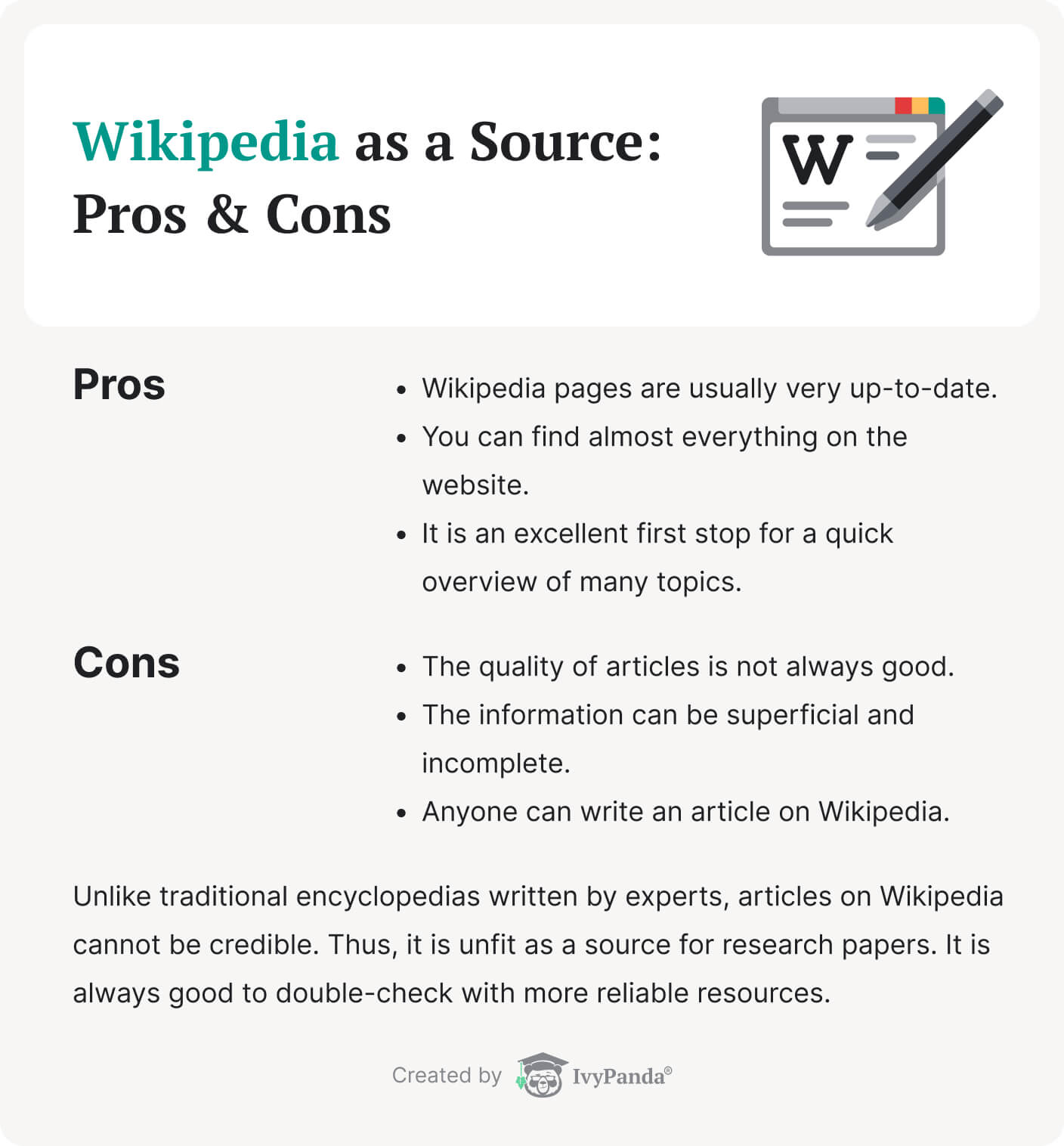
Here are some cons of using these online sources:
- Unreliable. Anyone can write websites, and they are rarely checked for accuracy, bias, and credibility. They are also regularly filled with old content.
- Chargeable. A lot of websites are free of charge. Yet, very often, to read the full article or cite the page you need, you have to pay.
- Tricky to cite. Most websites do not have any citation tools, so it can be hard to add them as references.
- Unstable. Websites are usually not permanent. Both the content and the address change – the link might not be available later on.
Free Websites to Use for Research
Using different websites for background information search and a general understanding of a given topic makes total sense. But when needed, you can use them for actual research.
For this purpose, we recommend the following websites:
- HowStuffWorks. HowStuffWorks is an American website that professor Marshall Brain founded. The topics include animals, culture, politics, and many more.
- Best Free Reference Web Sites. It is an index of all the best websites for research. The years range from 1999 to 2016.
- Digital Public Library of America. On this website, you can find more than 45 million images, texts, videos, and sounds from across the United States. DPLA can be used for scholarly research and education.
- ARTstor Public Collections. It is a public collection that offers more than one million images, videos, and documents. This general collection includes papers from Cornell University, MIT, RISD, and Colby College.
- USA.gov. This website is a place that you can use to search for topics. It is a part of Technology and Transformation Services. It also has a Spanish-language portal.
- Data.gov. It is the U.S. Government’s open data website. You can find information, tools, resources for successful research. It was launched in 2009 and hosted by the U.S. General Services Administration.
3. Evaluate the Sources
3.1. Select What Sources to Use
By this step, you have collected many materials for your work. Now is the time to sort through them and eliminate the ones you don’t need. Here, we will explain how to pick appropriate sources for your research.
When assessing the credibility of a source, use this checklist:
- Currency. The information that was relevant five years ago may not be accurate anymore. Thus, it is crucial to check for the currency of your sources. Even when regarding trustworthy publishers, take note of the dates of the studies.
- Purpose. Every single research is conducted with a particular agenda in mind. Sometimes, it is to pursue advancements in science. Other times, the focus may be political or economic. Ensure that you check who publishes the information you’re reading and what possible motive or bias they might have.
- Relevance. Any topic has various perspectives and several possible approaches. Not to mention, one area of inquiry can open the door to many others. Double-check that the data you’re studying is directly relevant to your research question.
- Authority. Consider who is publishing the information and what credentials the author has. Is this well-known research, or are you referring to someone’s opinion? Ensure that others can verify the statements you’re reading.
- Accuracy. It is up to you to confirm whether your sources are credible. Take into account the previous aspects from the checklist and let them navigate you. Assess the accuracy of the claims you’re reading before adding the source to your reference list.
- Publisher. Note if an academic press has released the article or book you’re considering. In this case, the chances are that it has been through a peer-review procedure, and the information is accurate. However, for data found on the web, you may have to fact-check the claims yourself.
3.2. Take Notes
When you have sorted through your bibliography, you can start reading through them at length. You will still have the opportunity to filter out unneeded information. To accomplish this, we recommend marking down the relevant fragments that you will apply in your work.
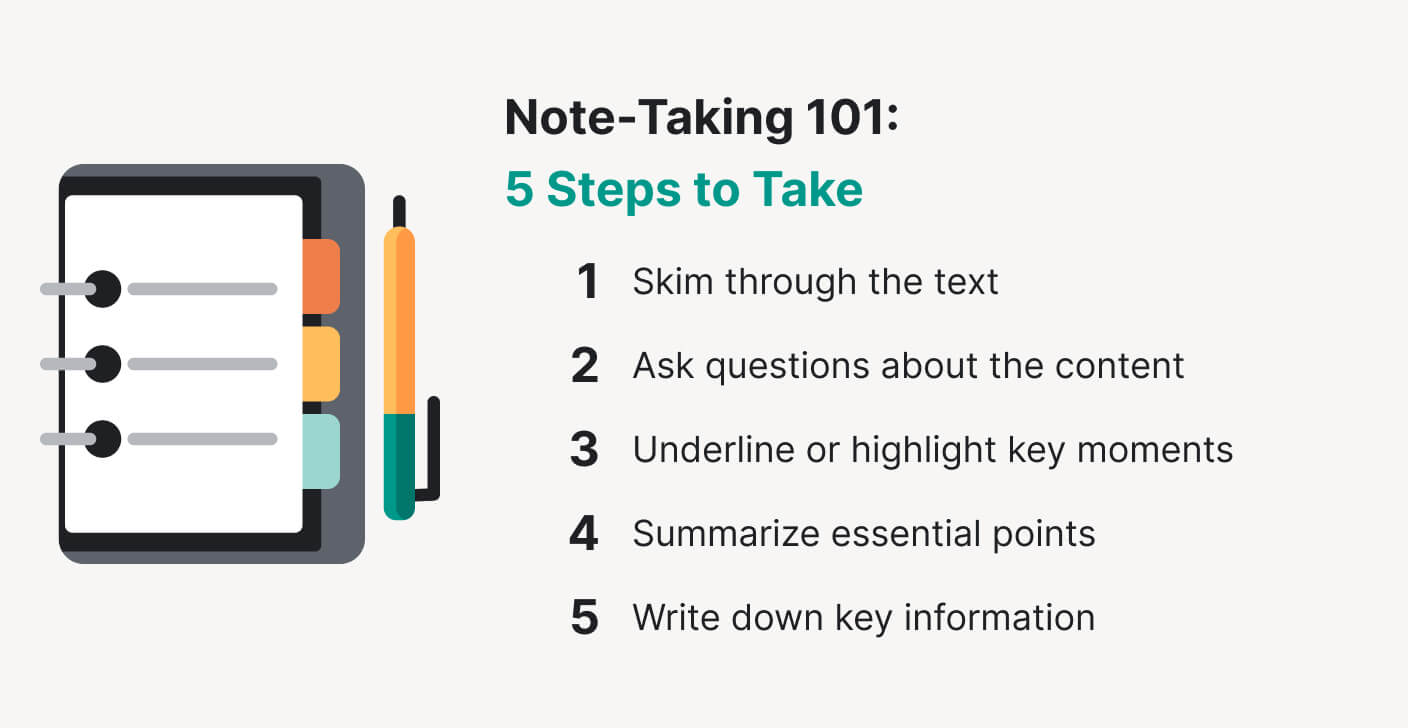
We advise you to study your sources in the following order:
Step 1: Skim through the text.
Don’t immediately spend an excessive amount of time reading paragraphs and paragraphs of text. First, run through the source to identify the most relevant passages and headings. Note any words or terminology that catch your eye. It will allow you to form a rough idea of the author’s main arguments.
Step 2: Ask questions.
After you finish skimming through the text, write down any questions that formed in your mind. Make sure that you keep them relevant to your topic. These questions will help you figure out what information you are hoping to obtain from the source.
Step 3: Underline or highlight.
It’s time to read the source actively. Grab a highlighter or a pen and note down anything that seems relevant or interesting. Pay special attention to the passages that caught your eye earlier. Once you find answers to your questions (or think of even more questions), make sure to jot them in the margins.
Step 4: Summarize.
As you have finished reading, write down a quick summary of your findings. Do this immediately after you finish while the information is still fresh in your mind. Organize your notes and look up any terminology that isn’t familiar. Also, take a quick look at the bibliography provided by the source – you could find something useful!
Step 5: Write down key information.
Before moving on to the next source, don’t forget to note everything you need for the bibliography. Write down the title, the author’s name, the publisher, and the date of publishing. If you are using a website, save the URL. Double-check which citation format you’re required to use.
4. Write Your Paper
4.1. Formulate Your Thesis
A thesis statement is often referred to as the heart of your work since it contains the main idea and stance of the author. The writing process starts with figuring out what you want to say. State it in one sentence, referring back to all the research that you have conducted thus far.
Here are a few tips you could use in writing a compelling thesis statement based on your research:
- State your point clearly. Your argument needs to be explicit and direct. Remember that you will have to address it within the limited confines of your work. There isn’t the space to consider too many points of view. That is why your audience must be clear on the direction your debate is going to follow.
- Be specific. You have to ensure that your wording is as clear-cut as possible. The thesis needs to state the exact idea you will be exploring. If you formulate it too vaguely, the content of your work will be all over the place. Polish your thesis until it becomes specific to your argument.
- Question what you think. To accomplish this, you will need to keep your target audience in mind. Consider what views your readers must have to understand the point you are trying to make. Your statement must be grounded to those who don’t necessarily have the same ideas as you.
- Showcase a strong position. Don’t forget that your thesis statement is a reflection of your comprehension of the topic. While it must be clear and coherent, it should also advance your unique position on the matter. Instead of simply making an observation about something, don’t hesitate to take a stance.
Formulating a successful thesis statement takes time and practice. It is likely that you will not get it completely right on your first try. If you feel like you need some training or require examples, try using our thesis statement generator.
4.2. Outline Your Paper
If you have reached this stage in your work process, it means that you have everything you need. You have composed a strong thesis statement and have your notes and arguments beside you. Now, you have to put them together in a logical order. This way, your reader will see your thought process clearly.

To organize your paper, try this approach:
- Determine the research problem. This isn’t just your thesis statement but is also the key to creating your title. It is the central point of your work. Try formulating it in a single sentence or phrase for efficiency.
- Identify the key arguments. Think of what points you are trying to make with your research. Very briefly note them in your introduction. You will proceed to explore and build on them throughout the rest of your paper.
- Formulate the first category. Consider which point you should cover first. Typically, it is a good idea to start with definitions and clarifications of any critical terminology. You may also want to introduce the background of a particular theory or concept you are exploring.
- Include subcategories if needed. For now, try listing them in the form of a bullet list. The subcategories should provide the basis and support the main points you’re making.
- Sum up and conclude. Once you have created the rough draft, tie everything together. Conclude your project and refer back to your thesis. Make sure that you haven’t strayed away from your research question in creating your outline.
If you have followed these steps, you should end up with a defined beginning, middle, and end. Naturally, different research papers will have carrying outlines. For example, a term paper will have a smaller number of subcategories than a dissertation. Moreover, some projects will require you to mention your research methods, results, etc. You can find more information on how to write an essay or another type of paper in specialized online guides.
4.3. Add Quotes and Examples
To prove that you aren’t making up arguments on the fly, you should provide supporting evidence. You have to refer back to your sources and cite articles and books found during your research.
You can cite a source as supporting evidence like this:
You will be rephrasing and analyzing others’ opinions on your chosen topic for most of your work. However, from time to time, a direct quotation is necessary to support your arguments. This is suitable in the following cases:
- You don’t want to lose the author’s original meaning by summarizing or paraphrasing their words.
- The language in the source material is very effective and would be weakened if you tried to reword it.
- The language that the author is using is important historically.
- The authority found in the source will lend more credibility to the point you are trying to make.
5. Cite Your Sources
Congratulations – your work is nearly finished! You have only a couple of steps left. To round up your research, compile a list of sources you have used. You should also indicate which parts you have cited in your text. That is what we are going to discuss in this section.
Simply put, a citation is used to refer back to the source material. You can cite anything, from an academic article or book to a video or even a viral tweet. This is how you give credit to the original author for their work.
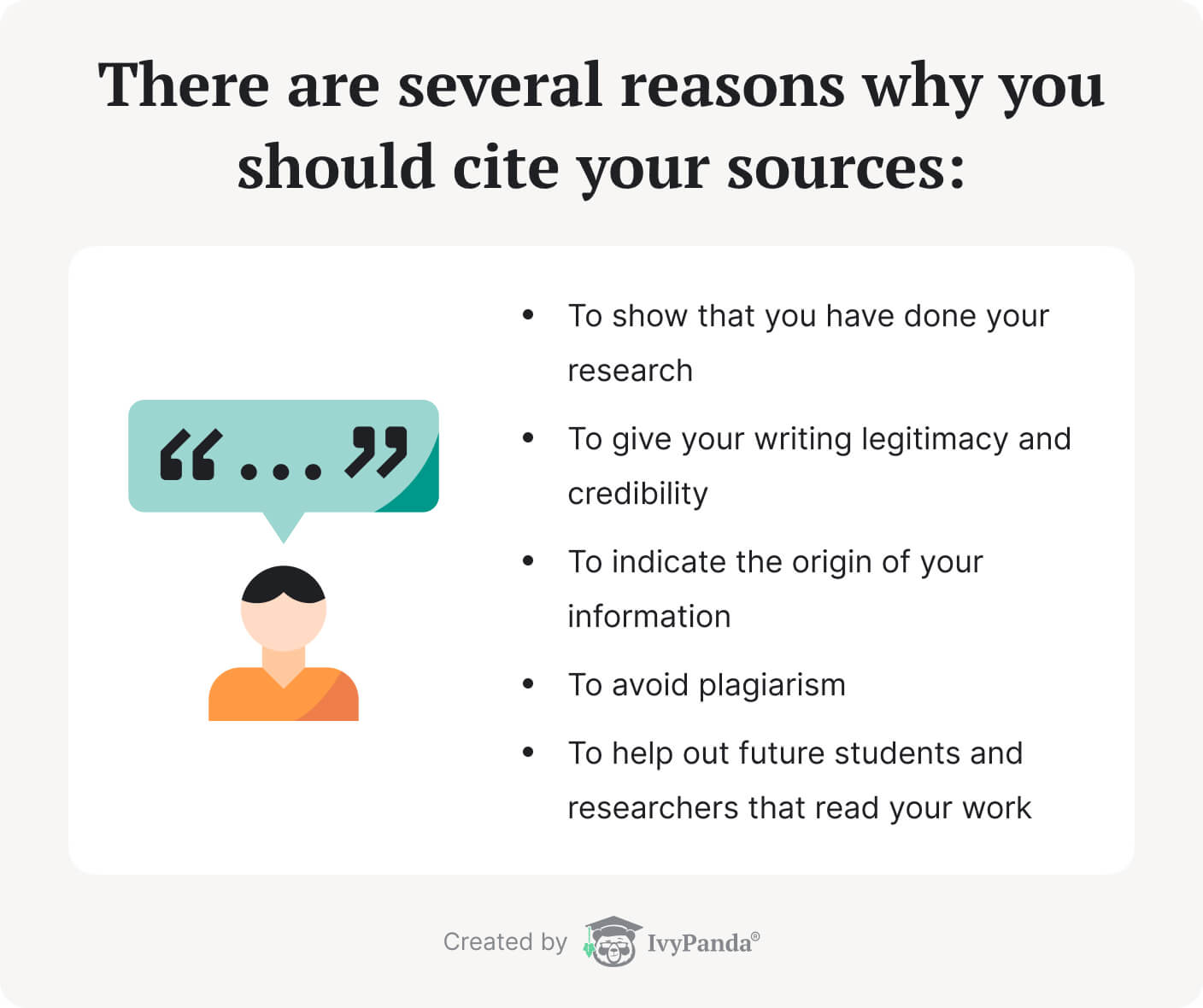
There are a couple of ways to utilize citations in your work correctly:
- When employing quotations, summarizing, or paraphrasing in your text, use in-text citations. These must be placed directly in the body of the work in parenthesis, following the cited fragment. The in-text citations are always shortened, referring only to the author and the year of publishing. Sometimes, for larger works, the page number is also included.
- The full citations go into the references/works cited page at the end of your work. This is also sometimes referred to as a bibliography. These include various features, such as the title of the work, the author’s name, date of publishing, etc. Different citation styles require different elements to be mentioned. Make sure to double-check which one your institution expects you to use.
As we mentioned, while creating any academic work, you are expected to use references. You will have to choose a particular citation style or be directed to one by your instructor. This style will be used consistently throughout your work. Each one has its specific features and guidelines.
Here is what you can expect from them:
You can read more about each citation style if you follow the links for the related referencing guides.
💡 9 Online Tools for Research
In the previous sections, we have examined search engines, databases, and websites that you can use in your research. However, there are plenty of other online tools that can be very useful for your work process. We are going to talk about them here.
The following online tools can help you immensely while you research:
- ProCon.org is a website that allows you to consider several viewpoints on debatable issues. It features multiple controversial topics and lets the readers experience different sides of the arguments in a non-biased manner.
- Journal TOCs is a service that allows you to discover the newest academic papers as soon as they are available online. When writing about current events, it is essential to stay up-to-date, especially concerning research.
- EndNote is a multifunctional tool with many valuable features. It provides you with fast database search, automatic bibliography, and more. Research takes an incredible amount of time and effort, and this program is determined to save you time and resources.
- Paperpile is an extension for your browser and can be installed on your mobile devices as well. Tracking down and compiling your references can become a hassle – this is why Paperpile manages them for you.
- Zotero is another useful extension for your browser. It collects and organizes your research for you. It can also help you with the creation of your citations and allows you to collaborate with others.
- RefWorks is a tool that allows you to save your references from any webpage. It also helps you import them from online databases. You will be able to annotate and highlight your texts, as well as quickly search through them.
- Science Daily allows its readers to browse through all the latest news in several different spheres. Keeping up with updates in the scientific sphere is essential for any researcher, but especially those in the STEM fields. ScienceDaily is a must-have if you need to save time.
- DeepDyve gives you access to different current research articles for a limited time. A large number of valuable sources online are locked behind a paywall. It tends to be troublesome and expensive. DeepDyve allows you to check articles for free to see whether you need them for your research or not.
Thank you for your attention! We hope that you are now feeling more prepared to approach research in any sphere. Share this page with other students who you think could use our guide.
🔗 References
- Basic Steps in the Research Process – North Hennepin Community College
- How to Do Research A Step-By-Step Guide: Get Started – LibGuides at Elmira College
- Conducting Research: the Process – Research Guides at Washington University in St. Louis
- Research Process: Select your Topic – Nash Library & Student Learning Commons at Gannon University
- Developing Research Questions – Research & Learning Online, Monash University
- How to Write a Research Question – Guides at The Writing Center, George Mason University
- Research Process Step by Step: Identify Keywords – Subject and Course Guides at University of Texas at Arlington
- Start Your Research: Evaluate Your Info – Library Guides at University of California, Santa Cruz
- 19 Notetaking Tips for College Students – Post University
- Writing a Paper: Outlining – Academic Guides at Walden University
- How to Outline – Purdue Online Writing Lab, College of Liberal Arts, Purdue University
- What Is Research: Definition, Types, Methods & Examples – QuestionPro
- Thesis Statements – The Writing Center, University of North Carolina at Chapel Hill
- 5 Steps to Create the Perfect Outline – Brandon Ramey, Herzing University
- How to Cite – University of Arizona Libraries
- The Research Process: How to Cite – LibGuides at Franklin & Marshall College
![How to Research: Ultimate Guide [+Online Tools]](https://ivypanda.com/blog/wp-content/uploads/2021/12/multiethnic-team-young-partners-having-meeting-cafeteria-discussing-plans-sharing-ideas-analyzing-financial-data-project-using-laptop-736x491.jpg)



Productive tips of information in advancing research skills. I recommend this content to all potential professionals. Thanks for your anticipatory contribution to all the budding academic and research communities.
This is strictly a rich content that goes along way in advancing the research prowess more importantly to the budding researchers. Thank you so much for this.
We are glad to hear your opinion! Thank you, Benard!